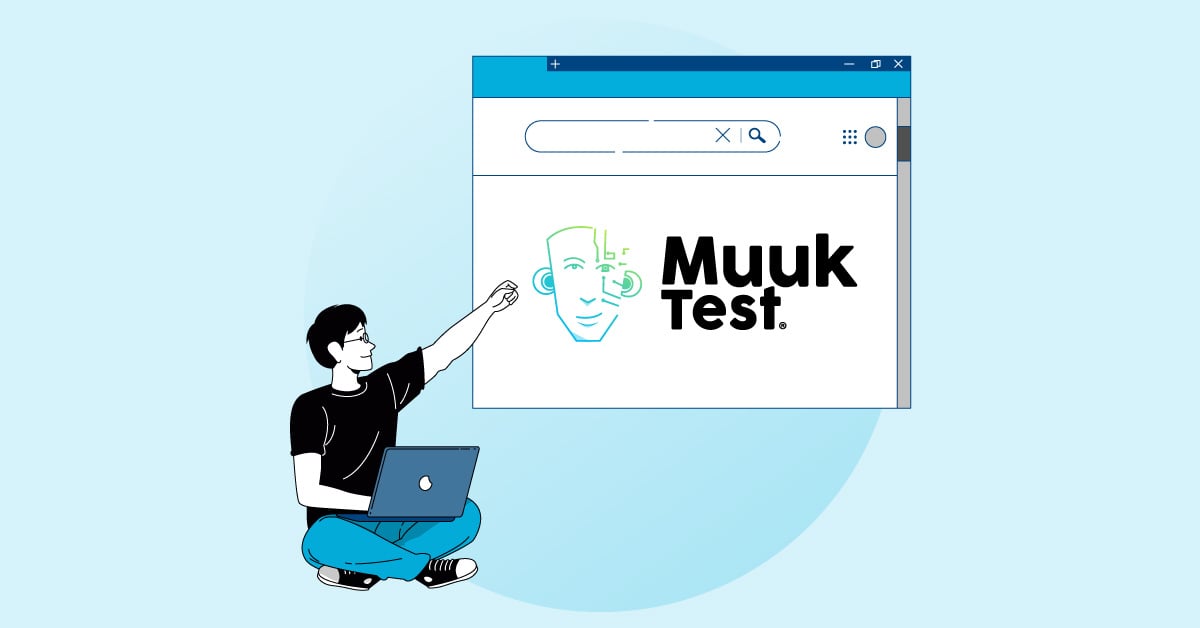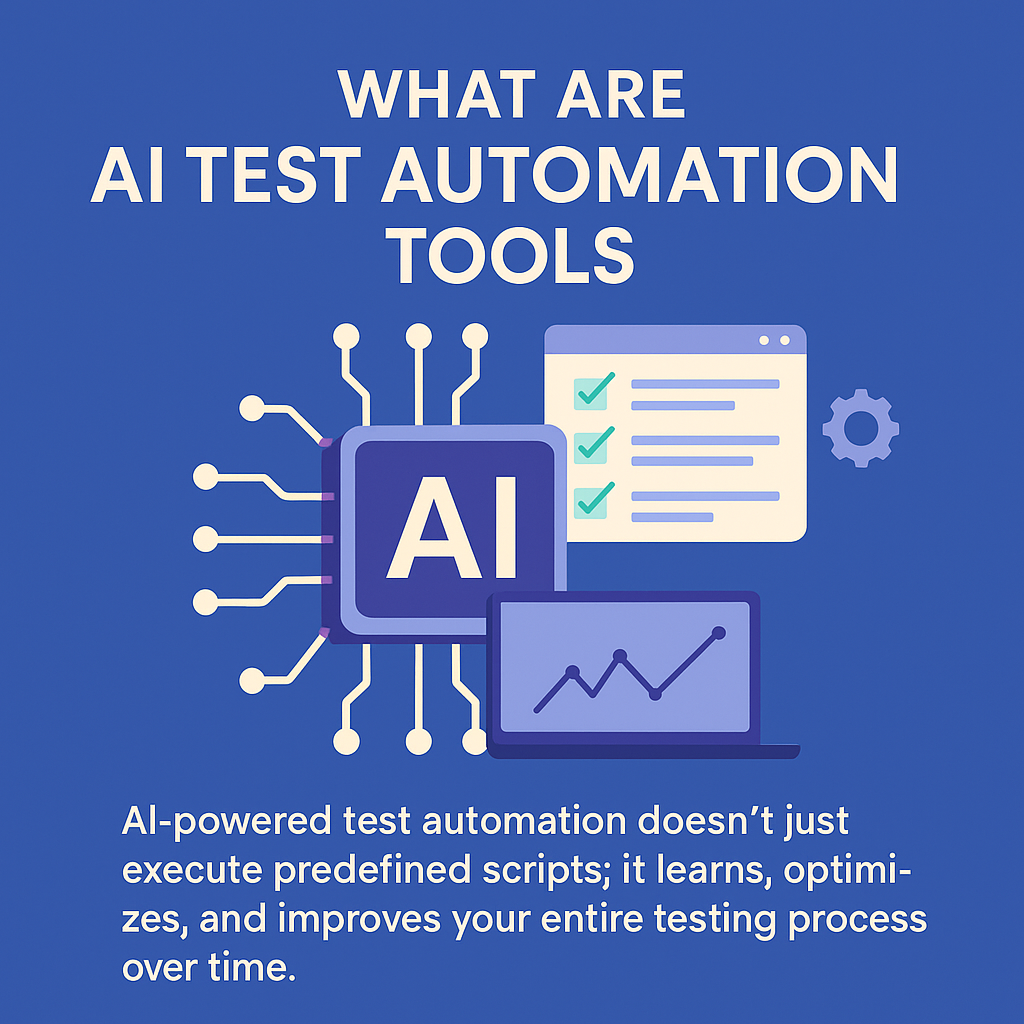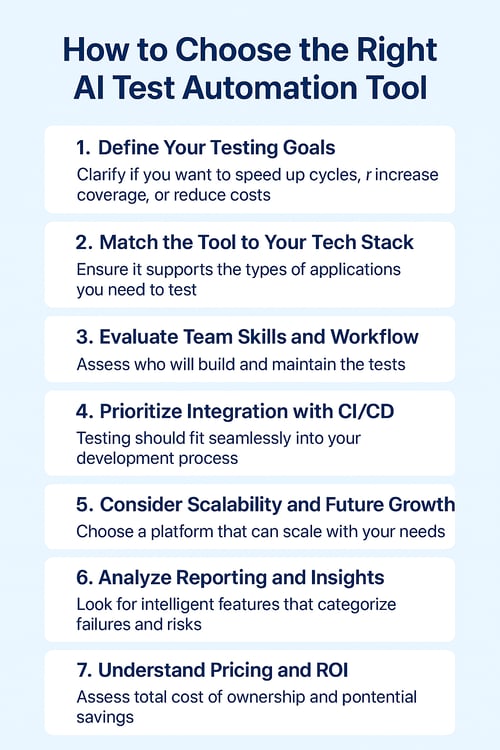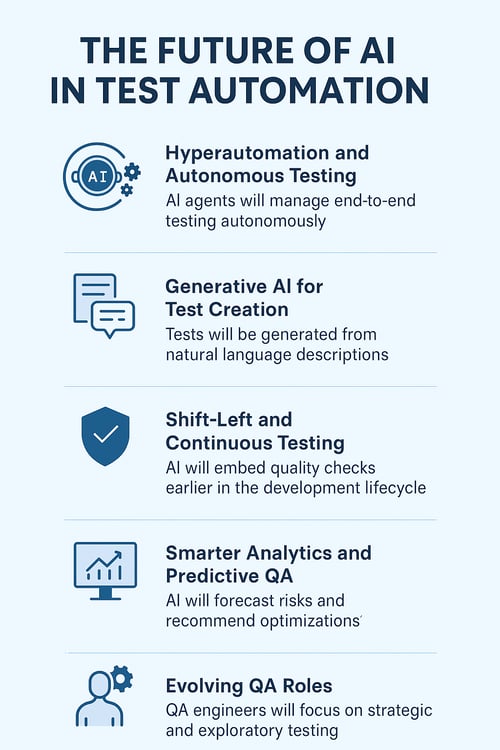Top AI Automation Testing Tools & Strategies in 2025
Author: The MuukTest Team
Published: April 25, 2025

Table of Contents
Software testing is undergoing a significant transformation as Artificial Intelligence (AI) reshapes the industry. With increasingly complex applications and faster Agile and DevOps cycles, traditional testing methods often struggle to keep pace.
That's where AI test automation tools step in, offering smarter testing, faster execution, and deeper coverage to help teams deliver high-quality software quickly.
Recent research highlights why change is happening fast. Only 16% of organizations believe their current testing practices are truly efficient (Leapwork, 2024). Meanwhile, the World Quality Report 2024 found that 68% of organizations are adopting or planning to adopt AI in quality engineering, with test automation cited as the leading use case (Intelligent CIO, 2024).
If your team aims to accelerate testing cycles, catch defects earlier, and reduce long-term maintenance efforts, then leveraging AI-driven testing tools is becoming increasingly essential.
In this guide, we’ll explore how AI is revolutionizing software testing, break down the key benefits of AI test automation, highlight the top features to look for when evaluating solutions, and provide a detailed comparison of the best AI test automation tools for 2025, including MuukTest and other top performers.
By the end, you'll have a clear understanding of how AI can future-proof your QA strategy and which tools are leading the way in this transformation.
Key Takeaways
- AI is transforming software testing by enabling faster execution, smarter prioritization, broader test coverage, and early defect detection, and addressing the challenges of modern Agile and DevOps cycles.
- AI test automation tools offer dynamic capabilities, such as self-healing scripts, intelligent test generation, predictive analytics, and adaptive execution, helping teams dramatically reduce maintenance efforts and improve release quality.
- Choosing the right AI tool is crucial, and it depends on your goals, tech stack, team skills, scalability needs, and integration with CI/CD pipelines.
- The future of testing is AI-driven, with trends such as hyperautomation, generative AI for test creation, shift-left strategies, predictive QA analytics, and the evolution of testers into strategic, AI-supervised roles.
What Are AI Test Automation Tools?
AI test automation tools are transforming how software quality is built and maintained. Instead of relying purely on hand-coded scripts and static workflows, these platforms use machine learning and artificial intelligence to make testing smarter, faster, and more resilient.
Here’s how they differ from traditional test automation:
-
Test creation is dynamic:
AI tools can generate test cases automatically based on user flows, application behavior, or requirements, reducing the need for manual scripting. -
Maintenance is minimized:
With self-healing capabilities, AI adapts to changes in UI elements or APIs, dramatically reducing maintenance time and preventing brittle tests. -
Defect detection becomes predictive:
By analyzing historical test runs and application changes, AI tools can prioritize testing on high-risk areas, catching critical bugs earlier. -
Test execution adapts in real-time:
Some AI systems adjust testing strategies on the fly, focusing more deeply on areas where early tests show instability, to ensure that no significant issues are missed.

In short:
AI-powered test automation doesn’t just execute predefined scripts; it learns, optimizes, and improves your entire testing process over time.
Key Capabilities of AI Test Automation Tools
When evaluating AI-driven platforms, you’ll often see features like:
-
Automatic test case generation
-
Smart defect prediction and prioritization
-
Self-healing test scripts
-
Visual testing powered by computer vision
-
Adaptive learning during test runs
These capabilities combine to create faster feedback loops, broader test coverage, and higher software quality, without requiring an exponential increase in manual effort.
Interested in how automation can level up mobile testing, too? Explore our Complete Guide to Mobile Testing Strategy.
Benefits of Using AI Test Automation Tools
The shift to AI-powered test automation brings a range of transformative benefits that impact speed, coverage, and cost-efficiency. All critical in today’s Agile and DevOps environments.
Here’s how AI testing tools are changing the game:
- Faster Test Execution and Smarter Prioritization
AI systems intelligently prioritize test cases based on risk and recent changes. Instead of executing large regression suites blindly, teams can focus on the areas most likely to break first. This smarter approach accelerates feedback cycles and supports faster, more confident releases. - Better Test Coverage and Accuracy
AI can automatically generate broader and more complex test scenarios, including edge cases often missed by manual scripting. Adaptive learning during execution ensures that even rapidly changing applications are thoroughly validated. Visual AI also detects subtle UI issues that traditional methods might overlook. - Long-Term Cost Efficiency
Self-healing automation means fewer hours spent maintaining fragile scripts after changes to the UI or API. Over time, AI-driven maintenance savings accumulate, significantly reducing the total cost of ownership for test automation efforts. - Early Defect Detection with Predictive Analytics
By analyzing historical results and application behavior, AI tools can predict risk areas and suggest where to focus testing. This proactive defect detection leads to faster fixes, reduced production incidents, and smoother releases.
To better understand the difference AI makes compared to traditional automation, here’s a quick comparison:
| Aspect | Traditional Automation | AI Test Automation |
|---|---|---|
| Test Creation | Manual scripting | Automatic test generation |
| Maintenance | High, frequent updates | Low, self-healing tests |
| Defect Detection | Reactive after failures | Predictive, proactive alerts |
| Test Execution | Fixed, static suites | Adaptive, risk-based selection |
| Optimization | Minimal | Continuous learning and improvement |
The bottom line: AI empowers QA teams to move beyond simply automating manual tests; it enables a smarter, faster, and more resilient approach to ensuring software quality.
Top Features to Look for in an AI Test Automation Tool
Not all AI-powered testing tools are created equal. To maximize the benefits of AI-driven automation, it’s essential to focus on solutions that offer the right combination of smart capabilities, flexibility, and scalability.
Here are the top features you should look for when evaluating AI test automation platforms:

Intelligent Test Case Generation
Instead of requiring manual scripting for every new feature, AI-based platforms can automatically generate test cases from user flows, requirements, or historical data. This accelerates test coverage and helps teams catch edge cases they might otherwise miss.
Self-Healing Test Scripts
A key differentiator of AI tools is the ability to automatically detect when an application's UI or APIs have changed and adjust the test scripts accordingly. Self-healing ensures tests remain stable even as your application evolves, drastically reducing the time spent on test maintenance.
Seamless CI/CD Integration
A modern AI test automation tool must easily integrate into your CI/CD pipelines. Look for solutions that can trigger tests automatically on code commits, support parallel execution, and feed test results directly back into your DevOps dashboards for continuous feedback.
Multi-Platform and Cross-Environment Support
Whether you’re testing web, mobile, desktop, or APIs, your AI testing tool should offer broad platform support. Tools that allow seamless testing across different devices, operating systems, and browsers ensure comprehensive coverage without complex setup.
Visual Testing Capabilities
AI-powered visual testing uses computer vision to compare application screens, intelligently flagging only meaningful differences. This ensures pixel-perfect UI validation across browsers, devices, and screen sizes, which is critical for delivering a consistent user experience.
Predictive Analytics and Risk-Based Testing
Leading AI tools analyze test results, code changes, and past defect patterns to identify high-risk areas before failures occur. Predictive analytics helps prioritize testing efforts intelligently, improving defect detection rates and optimizing QA resources.
Top AI Test Automation Tools in 2025
AI-driven testing platforms are transforming how organizations approach quality assurance, offering smarter automation, faster execution, and more in-depth defect detection.
Quick Comparison of Top AI Test Automation Tools
| Tool | Best For | Key Strengths | Considerations |
|---|---|---|---|
| MuukTest | Startups, mid-sized companies scaling automation | AI-powered rapid coverage (Amikoo), expert-guided QA, self-healing | Commercial use (not open-source) |
| Katalon Studio | Teams needing an all-in-one platform | Web, mobile, and API testing with smart healing | Enterprise workflows may need customization |
| LambdaTest | Cross-browser/device cloud testing | AI analytics, flaky test detection, and massive device lab | Focused on execution, not test creation |
| Tricentis Tosca | Large enterprises with complex systems | Model-based, Vision AI for robust automation | Higher learning curve, premium cost |
| BrowserStack | Teams ensuring multi-device/browser compatibility | Real device testing, AI-powered visual checks | External test creation is still needed |
| Applitools | Design/UX-critical applications | Visual AI testing, Ultrafast Grid scaling | Focuses mainly on UI validation |
| Testim | Agile teams need quick UI automation | Smart locators, reusable components, and low-code flexibility | Primarily web application focus |
| Mabl | DevOps teams practicing continuous testing | Unified API+UI testing, anomaly detection, CI/CD native | Less flexible for complex customizations |
| Parasoft | Enterprises modernizing Selenium/API suites | Self-healing for Selenium, risk-based execution | Best fit for regulated industries |
| Keysight Eggplant | Complex, cross-platform environments (legacy, IoT) | Image-based AI automation, end-to-end journeys | Specialized setup needed for full leverage |
Among the leaders driving this transformation is MuukTest, which has an innovative combination of AI-powered automation and human quality assurance (QA) expertise. Alongside MuukTest, several other platforms are pushing the boundaries of what test automation can achieve in today’s Agile and DevOps environments.
Here’s a detailed look at the top AI test automation tools to consider in 2025:
1. MuukTest
MuukTest is a next-generation AI-powered testing platform built to accelerate automation while ensuring quality and reliability. At the heart of MuukTest is Amikoo, an advanced AI agent developed through years of research funded by the National Science Foundation. Amikoo transforms regression testing by automating the creation, execution, and maintenance of test suites, achieving in days what would traditionally take months.
Unlike most tools that only offer automation frameworks, MuukTest uniquely combines AI technology with human QA expertise. This hybrid approach ensures not just faster automation, but also higher-quality, domain-relevant testing outcomes. Teams working with MuukTest often achieve over 95% end-to-end test coverage within three months, compared to the typical 8– 12 months with manual testing methods.
Key Features:
-
AI-driven test creation, maintenance, and optimization (powered by Amikoo)
-
Rapid achievement of 95 %+ test coverage
-
Self-healing automation to minimize script maintenance
-
No-code intuitive interface for rapid onboarding
-
Coverage for web, mobile, API, and desktop applications
-
Direct collaboration with MuukTest’s QA experts for continuous quality improvement
-
Integrations with Selenium, Playwright, Appium, and all major CI/CD pipelines
Pros: Fast, scalable automation with expert guidance; AI accelerates testing while humans ensure strategic quality.
Cons: Best suited for startups, mid-sized businesses, and growing organizations (not an open-source or community tool).
2. Katalon Studio
Katalon Studio offers an all-in-one platform for web, mobile, API, and desktop testing. It combines low-code scripting with AI-enhanced object detection and self-healing capabilities, making automation accessible to a wide range of teams.
Key Features:
-
Cross-platform testing (Web, Mobile, API, Desktop)
-
Smart XPath and object auto-healing
-
Advanced analytics and reporting
-
Seamless CI/CD integrations
-
Free version available with paid enterprise upgrades
Pros: Versatile and beginner-friendly, strong community support
Cons: May require customization for complex enterprise workflows
3. LambdaTest
LambdaTest provides a cloud-based platform for automated cross-browser and mobile app testing. Its AI-driven analytics help identify flaky tests, categorize errors, and optimize execution based on trends.
Key Features:
-
3000+ browsers and devices available for testing
-
AI-powered flakiness detection and error classification
-
HyperExecute for faster test orchestration
-
Integration with Selenium, Cypress, Playwright
-
CI/CD ready with parallel execution
Pros: Excellent scalability, strong analytics
Cons: Limited to execution and insights (no in-built test creation)
4. Tricentis Tosca
Tricentis Tosca is an enterprise-grade test automation platform focused on model-based and scriptless automation. Its Vision AI technology enables robust UI testing, even on complex and legacy applications.
Key Features:
-
Model-based test automation
-
Vision AI for visual object recognition
-
Risk-based optimization of test suites
-
End-to-end support for SAP, Salesforce, Oracle, and more
-
Native integrations with CI/CD pipelines
Pros: Ideal for complex systems and large enterprises
Cons: Higher learning curve and premium pricing
5. BrowserStack
BrowserStack is a cloud testing platform that offers real-device testing for web and mobile apps. Its Percy visual testing tool uses AI to detect UI regressions, ensuring smooth experiences across platforms intelligently.
Key Features:
-
Access to real iOS, Android devices, and desktop browsers
-
Percy AI visual testing for UI consistency
-
Selenium, Cypress, Appium compatibility
-
Live and automated testing
-
Strong integrations with popular CI/CD tools
Pros: Easy setup, wide device/browser coverage
Cons: Test creation must be done externally (focus on execution)
6. Applitools
Applitools specializes in Visual AI, helping teams catch visual bugs that traditional testing misses. Its Ultrafast Grid technology accelerates cross-browser testing while ensuring pixel-perfect accuracy.
Key Features:
-
AI-powered Visual Testing (Applitools Eyes)
-
Ultrafast Grid for parallel rendering
-
Visual comparisons with smart difference detection
-
Works with Selenium, Cypress, Playwright, and others
-
Supports web, mobile, and PDF testing
Pros: Best for design-critical applications
Cons: Primarily focuses on visual validation (not full functional testing)
7. Testim
Testim offers fast, AI-augmented test creation with smart locators that automatically adapt to application changes. Its focus is helping Agile teams maintain stable, fast-moving test suites without heavy maintenance.
Key Features:
-
AI-based smart element locators
-
Self-healing tests
-
Low-code editor with custom JavaScript support
-
Reusable components for modular test design
-
Seamless CI/CD pipeline integration
Pros: Quick test creation, great for Agile sprints
Cons: Primarily focused on web applications
8. Mabl
Mabl is a cloud-native platform combining UI, API, and PDF testing into a single solution. Its AI automatically heals tests, detects performance issues, and highlights anomalies during execution.
Key Features:
-
Unified platform for UI and API testing
-
Auto-healing and intelligent failure detection
-
Anomaly detection in performance metrics
-
Tight CI/CD integrations (Jenkins, GitHub Actions, etc.)
-
Low-code/no-code test creation
Pros: Great fit for DevOps pipelines and continuous testing
Cons: Limited customization compared to fully open frameworks
9. Parasoft
Parasoft strengthens traditional automation with AI-driven self-healing and test impact analysis. It’s particularly strong for organizations already using Selenium or needing API and service virtualization.
Key Features:
-
Self-healing Selenium tests (Parasoft Selenic)
-
API and security testing capabilities
-
Test impact analysis to prioritize executions
-
Service virtualization for backend systems
-
Centralized reporting and analytics
Pros: Enhances existing test infrastructure without full replacement
Cons: Primarily targeted at large, regulated enterprises
10. Keysight Eggplant
Eggplant specializes in AI-powered, image-based automation across all platforms — web, mobile, desktop, and even custom hardware systems. It’s ideal for organizations testing non-traditional applications.
Key Features:
-
Image-based intelligent automation
-
Model-based exploratory testing
-
End-to-end journey validation
-
Supports mobile, desktop, mainframes, and IoT devices
-
Performance and usability testing included
Pros: Best for testing complex and cross-platform systems
Cons: May require specialized test strategy and setup effort
How to Choose the Right AI Test Automation Tool

Selecting the right AI test automation tool is a critical decision that can significantly impact the success of your QA strategy. The best solution for your team will depend on your specific needs, goals, and resources, not just flashy features.
Here’s what you should carefully evaluate:
1. Define Your Testing Goals
Start by clarifying what you want to achieve. Are you focused on speeding up regression cycles, increasing test coverage, improving mobile quality, or reducing maintenance costs?
Different AI tools specialize in various strengths, so aligning with your primary objectives is key.
2. Match the Tool to Your Tech Stack
Consider the types of applications you need to test, such as web, mobile, API, desktop, or even legacy systems. The tool should support your environments natively or integrate easily with your frameworks and CI/CD pipelines.
3. Evaluate Team Skills and Workflow
Think about who will build and maintain the tests. If your team includes manual testers or product owners, a no-code or low-code solution with AI assistance, such as MuukTest or Testim, might be ideal.
If you have seasoned automation engineers, a tool that allows deeper customization could be a better fit.
4. Prioritize Integration with CI/CD
Modern testing needs to be continuous. Look for tools that integrate seamlessly with your version control (GitHub, GitLab), CI/CD pipelines (Jenkins, Azure DevOps), and reporting systems.
This ensures that testing becomes a natural part of your development workflow, not an afterthought.
5. Consider Scalability and Future Growth
You may start with a handful of test cases today, but what about six months from now?
Choose a platform that can scale with you, handling larger suites, more complex workflows, and broader platform coverage as you grow.
6. Analyze Reporting and Insights
Great AI tools don’t just run tests. They help you understand your application’s health.
Look for intelligent reporting features like flakiness detection, failure categorization, and risk-based insights to help your team make more thoughtful decisions faster.
7. Understand Pricing and ROI
Finally, evaluate the commercial model: subscription vs license, per-user vs per-test pricing, etc.
Consider the total cost of ownership, including the savings you gain from faster automation setup, reduced maintenance, and early defect detection.
A tool that looks more expensive upfront might save you far more in long-term QA costs.
Choosing the right AI test automation platform isn't about picking the tool with the most features; it's about finding the best fit for your goals, team, and future roadmap.
When done thoughtfully, the right solution can elevate your QA practice and give your team a true competitive advantage.
The Future of AI in Test Automation

AI in testing is not just a passing trend; it’s the foundation for the next generation of quality assurance.
Over the next few years, we will see AI evolve beyond creating simple tests or self-healing scripts.
Here’s what’s shaping the future of software testing:
- Hyperautomation and Autonomous Testing
The future points toward hyperautomation, where AI agents don’t just support testing, they manage it end-to-end. Systems like Amikoo are early examples of how AI can autonomously generate, maintain, and optimize entire test suites, adapting continuously as applications change. This evolution reflects a growing reliance on artificial intelligence development solutions to drive smarter, self-managing software systems across all phases of the SDLC. - Generative AI for Test Creation
Advances in generative AI mean testers will soon be able to describe tests in natural language, and AI will generate complete, executable tests across web, mobile, and API layers, drastically reducing the time from idea to coverage. - Shift-Left and Continuous Testing
AI will play a significant role in shift-left strategies, embedding quality checks earlier in the development lifecycle. We’ll see more intelligent test bots that review pull requests, analyze user stories, and automatically trigger risk-based tests before code is even merged. - Smarter Analytics and Predictive QA
Instead of just reporting pass/fail outcomes, AI will deliver predictive analytics, highlighting modules at risk, forecasting release readiness, and recommending test optimizations.
Testing will become a data-driven strategic asset, not just a final checkbox. - Evolving QA Roles
As AI takes over repetitive and maintenance-heavy tasks, QA engineers will shift into strategic roles: focusing on exploratory testing, ethical validation, user experience, and AI supervision. The testers of tomorrow won’t just build scripts. They’ll train, guide, and monitor AI quality systems.
The takeaway: Teams that embrace AI in testing today will set the standards for software quality tomorrow.
Those who wait may find it harder to keep up in a world that demands faster, smarter, and more resilient applications.
Conclusion
AI is no longer an emerging trend in testing; it’s the new standard. Teams that leverage AI test automation tools are moving faster, covering more ground, and catching defects earlier than ever before.
Whether it’s self-healing scripts, predictive analytics, or AI-driven test creation, the benefits are clear:
Smarter automation leads to better software quality, quicker releases, and less maintenance overhead.
The key is choosing the right solution, one that fits your technology stack, your team’s expertise, and your long-term goals.
If you’re ready to accelerate your QA journey with AI-powered automation, there’s never been a better time to start.
See how MuukTest, with its powerful Amikoo AI agent, can transform your testing process.
Request a personalized demo today! Deliver better software, faster, and stay ahead of what’s next.
Frequently Asked Questions
What is AI in software testing?
AI in software testing refers to the use of artificial intelligence and machine learning techniques to automate and optimize various aspects of testing. Instead of relying solely on manually scripted tests, AI systems can create tests, prioritize execution, adapt to changes, and intelligently analyze results, helping teams test smarter, faster, and with broader coverage.
What are the best AI test automation tools?
Some of the best AI test automation tools in 2025 include MuukTest, Katalon Studio, LambdaTest, Tricentis Tosca, BrowserStack, Applitools, Testim, Mabl, Parasoft, and Keysight Eggplant.
Each platform offers different strengths, depending on your team’s needs, such as rapid no-code automation, visual AI validation, large-scale cross-browser testing, or enterprise-grade risk management.
Can AI replace manual testers?
AI is not meant to replace manual testers. Instead, AI enhances testing by automating repetitive tasks, reducing maintenance, and providing predictive insights. Human testers are still essential for exploratory testing, user experience evaluation, strategy planning, and supervising AI-driven processes. The future of testing is a collaboration between humans and AI, combining creative thinking with machine precision.
How do AI tools improve software testing?
AI tools improve software testing by making execution faster, enhancing coverage by generating additional test scenarios, and reducing maintenance through self-healing capabilities. They also help predict risks earlier in the development cycle by analyzing historical data and trends, allowing teams to focus on high-risk areas proactively. Additionally, AI enhances the accuracy of defect detection, particularly for visual inconsistencies and performance anomalies, resulting in faster releases and improved overall software quality.
Related Posts:

Mobile Automation Testing Guide: Tools, Tips & Trends
With billions of smartphone users worldwide, ensuring your mobile app works flawlessly on every device is critical. That’s where mobile automation testing tools come in. These tools help QA teams...

Checklist For Mobile App Testing Strategy
It seems impossible to go a day without having our phones on us. Whether we’re checking email and bank statements, shopping, playing games, or even following GPS directions, our mobile devices are a...

App Testing: Your Guide to a Flawless User Experience
In the competitive world of app development, a smooth, bug-free experience is no longer a luxury—it's an expectation. Users have little patience for apps that crash, freeze, or simply don't work as...
%20(1).png?width=150&height=69&name=MuukTest-logo---light-background%20(3)%20(1).png)

